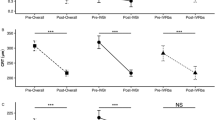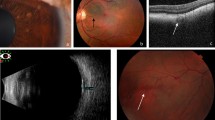Abstract
Purpose
To investigate changes in fundus autofluorescence (FAF) during 3 years of follow-up in patients with polypoidal choroidal vasculopathy (PCV).
Design
Retrospective study.
Methods
We retrospectively reviewed the charts of 48 eyes of 47 patients (35 men, 12 women; mean age, 69.9 ± 7.1 years) with treatment-naïve PCV for whom FAF and indocyanine green angiography (ICGA) images were available at baseline and at 3 years ± 3 months follow-up examination. The main outcome measures were the FAF changes during 3 years of follow-up, and the correlation between them and polypoidal lesions and branching vascular networks on ICGA.
Results
The FAF of the polypoidal lesions showed three patterns at baseline and changes during 3 years of follow-up: confluent hypoautofluorescence surrounded by a hyperautofluorescent ring (86.1 % → 51.4 %), confluent hypoautofluorescence without a ring (8.3 % → 43.0 %), and no marked changes (5.6 % → 5.6 %). The FAF in 96.2 % of resolved polypoidal lesions persisted on images with abnormal FAF during the 3 years of follow-up. The granular hypoautofluorescence at the branching vascular networks at baseline became partially confluent hypoautofluorescence in 41 eyes (85.4 %). The mean area with confluent hypoautofluorescence that corresponded to the branching vascular network lesions increased significantly (P < 0.001) from 1.75 mm2 to 5.10 mm2 after 3 years of follow-up.
Conclusion
The FAF changes in PCV during the 3 years of follow-up can indicate that FAF imaging is a useful and clinically beneficial tool for noninvasively evaluating the PCV lesions and disorders of the upper retinal pigment epithelium.




Similar content being viewed by others
References
Yannuzzi LA, Sorenson J, Spaide RF, Lipson B (1990) Idiopathic polypoidal choroidal vasculopathy (IPCV). Retina 10(1):1–8
Spaide RF, Yannuzzi LA, Slakter JS, Sorenson J, Orlach DA (1995) Indocyanine green videoangiography of idiopathic polypoidal choroidal vasculopathy. Retina 15(2):100–110
Yannuzzi LA, Ciardella A, Spaide RF, Rabb M, Freund KB, Orlock DA (1997) The expanding clinical spectrum of idiopathic polypoidal choroidal vasculopathy. Arch Ophthalmol 115(4):478–485
Yannuzzi LA, Nogueira FB, Spaide RF, Guyer DR, Orlock DA, Colombero D, Freund KB (1998) Idiopathic polypoidal choroidal vasculopathy: a peripheral lesion. Arch Ophthalmol 116(3):382–383
Wakabayashi T, Gomi F, Sawa M, Tsujikawa M, Nishida K (2012) Intravitreal bevacizumab for exudative branching vascular networks in polypoidal choroidal vasculopathy. Br J Ophthalmol 96(3):394–399
Hikichi T, Higuchi M, Matsushita T, Kosaka S, Matsushita R, Takami K, Ohtsuka H, Ariga H (2012) One-year results of three monthly ranibizumab injections and as-needed reinjections for polypoidal choroidal vasculopathy in Japanese patients. Am J Ophthalmol 154(1):117–124 e1
Ojima Y, Hangai M, Sakamoto A, Tsujikawa A, Otani A, Tamura H, Yoshimura N (2009) Improved visualization of polypoidal choroidal vasculopathy lesions using spectral-domain optical coherence tomography. Retina 29(1):52–59
Sato T, Kishi S, Watanabe G, Matsumoto H, Mukai R (2007) Tomographic features of branching vascular networks in polypoidal choroidal vasculopathy. Retina 27(5):589–594
von Ruckmann A, Fitzke FW, Bird AC (1997) Fundus autofluorescence in age-related macular disease imaged with a laser scanning ophthalmoscope. Invest Ophthalmol Vis Sci 38(2):478–486
von Ruckmann A, Fitzke FW, Bird AC (1997) In vivo fundus autofluorescence in macular dystrophies. Arch Ophthalmol 115(5):609–615
Delori FC, Dorey CK, Staurenghi G, Arend O, Goger DG, Weiter JJ (1995) In vivo fluorescence of the ocular fundus exhibits retinal pigment epithelium lipofuscin characteristics. Invest Ophthalmol Vis Sci 36(3):718–729
Holz FG, Bellman C, Staudt S, Schutt F, Volcker HE (2001) Fundus autofluorescence and development of geographic atrophy in age-related macular degeneration. Invest Ophthalmol Vis Sci 42(5):1051–1056
Yamagishi T, Koizumi H, Yamazaki T, Kinoshita S (2012) Fundus autofluorescence in polypoidal choroidal vasculopathy. Ophthalmology 119(8):1650–1657
Sayegh RG, Simader C, Scheschy U, Montuoro A, Kiss C, Sacu S, Kreil DP, Prünte C, Schmidt-Erfurth U (2011) A systematic comparison of spectral-domain optical coherence tomography and fundus autofluorescence in patients with geographic atrophy. Ophthalmology 118(9):1844–1851
Otsuji T, Takahashi K, Fukushima I, Uyama M (2000) Optical coherence tomographic findings of idiopathic polypoidal choroidal vasculopathy. Ophthalmic Surg Lasers 31(3):210–214
Iijima H, Iida T, Imai M, Gohdo T, Tsukahara S (2000) Optical coherence tomography of orange-red subretinal lesions in eyes with idiopathic polypoidal choroidal vasculopathy. Am J Ophthalmol 129(1):21–26
Ueno C, Gomi F, Sawa M, Nishida K (2012) Correlation of indocyanine green angiography and optical coherence tomography findings after intravitreal ranibizumab for polypoidal choroidal vasculopathy. Retina 94(3):297–301
Akaza E, Yuzawa M, Mori R (2011) Three-year follow-up results of photodynamic therapy for polypoidal choroidal vasculopathy. Jpn J Ophthalmol 55(1):39–44
Kokame GT, Yeung L, Lai JC (2010) Continuous anti-VEGF treatment with ranibizumab for polypoidal choroidal vasculopathy: 6-month results. Br J Ophthalmol 94(3):297–301
Saito M, Iida T, Kano M (2011) Intravitreal ranibizumab for polypoidal choroidal vasculopathy with recurrent or residual exudation. Retina 31(8):1589–1597
Acknowledgments
All authors have completed and submitted the ICMJE Form for Disclosure of Potential Conflicts of Interest, and none were reported. Involved in design (M.S., F.G.), conduct (M.S., F.G.), data collection (M.S., F.G., C.U., M.S.), analysis and interpretation of the data (M.S., F.G.), and preparation and review of the manuscript (M.S., F.G., K.N.). The institutional review board of Osaka University Hospital, Osaka, Japan, approved this retrospective study. The data collection complied with Japanese law. The study was conducted in accordance with the provisions of the Declaration of Helsinki.
Author information
Authors and Affiliations
Corresponding author
Rights and permissions
About this article
Cite this article
Suzuki, M., Gomi, F., Sawa, M. et al. Changes in fundus autofluorescence in polypoidal choroidal vasculopathy during 3 years of follow-up. Graefes Arch Clin Exp Ophthalmol 251, 2331–2337 (2013). https://doi.org/10.1007/s00417-013-2336-1
Received:
Revised:
Accepted:
Published:
Issue Date:
DOI: https://doi.org/10.1007/s00417-013-2336-1




